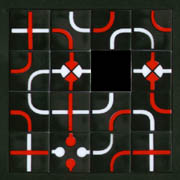 4.) What happens
if I get the points connected with my color but in the same move
my opponent's color also forms a complete path between the goal
points?
4.) What happens
if I get the points connected with my color but in the same move
my opponent's color also forms a complete path between the goal
points?|
|
|
|
|
|
|
|
1.) How many tiles can you move on your turn?
The rules use a slightly confusing but clear (if you think about it) turn of phrase: You take turns moving the hole. You can move the hole by moving any number of tiles in one motion, i.e. 1, 2 or 3 tiles can be slide at once to place the hole in a new location. This means that in any situation, you can move up to 3 tiles along either axis, making for a total of 6 possible moves on each turn. However, since you can't undo the previous move, you really only have 5 options during each turn.
2.) Do the goal points have to stay in the corners?
No! That's just where they start. They can be moved just like any other tiles. In fact, you'll usually want to move them closer to each other, to make it easier for you to connect them with your color. But be careful - moving the goal points closer also makes it easier for your opponent to win!
3.) What does the stopper tile do?
Nothing. It just gets in the way. It breaks up connections, so you'll want to try to put it in the path your opponent is creating, rather than your own.
 4.) What happens
if I get the points connected with my color but in the same move
my opponent's color also forms a complete path between the goal
points?
4.) What happens
if I get the points connected with my color but in the same move
my opponent's color also forms a complete path between the goal
points?
It's a tie, unless you declare in advance a house rule that says the person whose path is longest wins in such a situation.
5.) It seems like the game will never end if you play strictly and vigilently defensively. Is a checkmate-type situation possible?
Yes. In the example shown here, the white player will win regardless
of what move the red player makes next. (Of course, setting this
up is a bit tricky...)